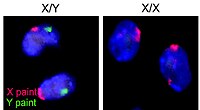
Photo from wikipedia
Obesity is a public health problem worldwide, and especially in women in reproductive age where more than one in three have obesity. Maternal obesity is associated with an increased maternal,… Click to show full abstract
Obesity is a public health problem worldwide, and especially in women in reproductive age where more than one in three have obesity. Maternal obesity is associated with an increased maternal, placental, and newborn oxidative stress, which has been proposed as a central factor in vascular dysfunction in large‐for‐gestational‐age (LGA) newborn. However, cellular and molecular mechanisms behind this effect have not been elucidated. Untreated human umbilical artery endothelial cells (HUAEC) from LGA (LGA‐HUAEC) presented higher O2− levels, superoxide dismutase activity and heme oxygenase 1 messenger RNA (mRNA) levels, paralleled by reduced GSH:GSSG ratio and NRF2 mRNA levels. In response to an oxidative challenge (hydrogen peroxide), only HUAEC from LGA exhibited an enhanced Glutathione Peroxidase 1 (GPX1) expression, as well as a more efficient antioxidant machinery measured by the biosensor probe, HyPer. An open state of chromatin in the TSS region of GPX1 in LGA‐HUAEC was evidenced by the DNase‐HS assay. Altogether, our data indicate that LGA‐HUAEC have an altered cellular and molecular antioxidant system. We propose that a chronic pro‐oxidant intrauterine milieu, as evidenced in pregestational obesity, could induce a more efficient antioxidant system in fetal vascular cells, which could be maintained by epigenetic mechanism during postnatal life.
Journal Title: Journal of Cellular Physiology
Year Published: 2019
Link to full text (if available)
Share on Social Media: Sign Up to like & get
recommendations!